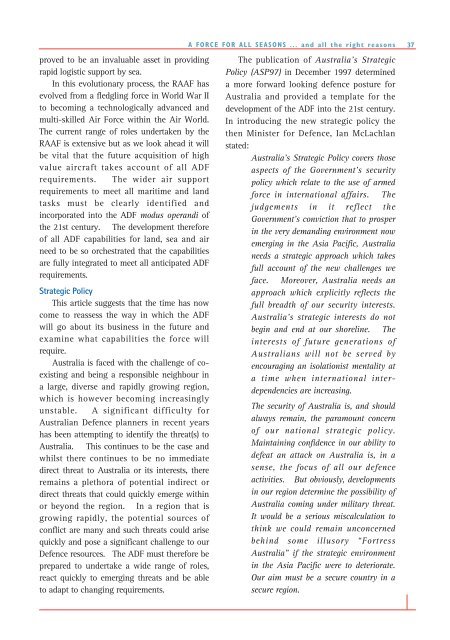ISSUE 150 : Sep/Oct - 2001 - Australian Defence Force Journal
ISSUE 150 : Sep/Oct - 2001 - Australian Defence Force Journal
ISSUE 150 : Sep/Oct - 2001 - Australian Defence Force Journal
You also want an ePaper? Increase the reach of your titles
YUMPU automatically turns print PDFs into web optimized ePapers that Google loves.
proved to be an invaluable asset in providingrapid logistic support by sea.In this evolutionary process, the RAAF hasevolved from a fledgling force in World War IIto becoming a technologically advanced andmulti-skilled Air <strong>Force</strong> within the Air World.The current range of roles undertaken by theRAAF is extensive but as we look ahead it willbe vital that the future acquisition of highvalue aircraft takes account of all ADFrequirements. The wider air supportrequirements to meet all maritime and landtasks must be clearly identified andincorporated into the ADF modus operandi ofthe 21st century. The development thereforeof all ADF capabilities for land, sea and airneed to be so orchestrated that the capabilitiesare fully integrated to meet all anticipated ADFrequirements.Strategic PolicyThis article suggests that the time has nowcome to reassess the way in which the ADFwill go about its business in the future andexamine what capabilities the force willrequire.Australia is faced with the challenge of coexistingand being a responsible neighbour ina large, diverse and rapidly growing region,which is however becoming increasinglyunstable. A significant difficulty for<strong>Australian</strong> <strong>Defence</strong> planners in recent yearshas been attempting to identify the threat(s) toAustralia. This continues to be the case andwhilst there continues to be no immediatedirect threat to Australia or its interests, thereremains a plethora of potential indirect ordirect threats that could quickly emerge withinor beyond the region. In a region that isgrowing rapidly, the potential sources ofconflict are many and such threats could arisequickly and pose a significant challenge to our<strong>Defence</strong> resources. The ADF must therefore beprepared to undertake a wide range of roles,react quickly to emerging threats and be ableto adapt to changing requirements.A FORCE FOR ALL SEASONS ... and all the right reasons 37The publication of Australia’s StrategicPolicy (ASP97) in December 1997 determineda more forward looking defence posture forAustralia and provided a template for thedevelopment of the ADF into the 21st century.In introducing the new strategic policy thethen Minister for <strong>Defence</strong>, Ian McLachlanstated:Australia’s Strategic Policy covers thoseaspects of the Government’s securitypolicy which relate to the use of armedforce in international affairs. Thejudgements in it reflect theGovernment’s conviction that to prosperin the very demanding environment nowemerging in the Asia Pacific, <strong>Australian</strong>eeds a strategic approach which takesfull account of the new challenges weface. Moreover, Australia needs anapproach which explicitly reflects thefull breadth of our security interests.Australia’s strategic interests do notbegin and end at our shoreline. Theinterests of future generations of<strong>Australian</strong>s will not be served byencouraging an isolationist mentality ata time when international interdependenciesare increasing.The security of Australia is, and shouldalways remain, the paramount concernof our national strategic policy.Maintaining confidence in our ability todefeat an attack on Australia is, in asense, the focus of all our defenceactivities. But obviously, developmentsin our region determine the possibility ofAustralia coming under military threat.It would be a serious miscalculation tothink we could remain unconcernedbehind some illusory “FortressAustralia” if the strategic environmentin the Asia Pacific were to deteriorate.Our aim must be a secure country in asecure region.
















